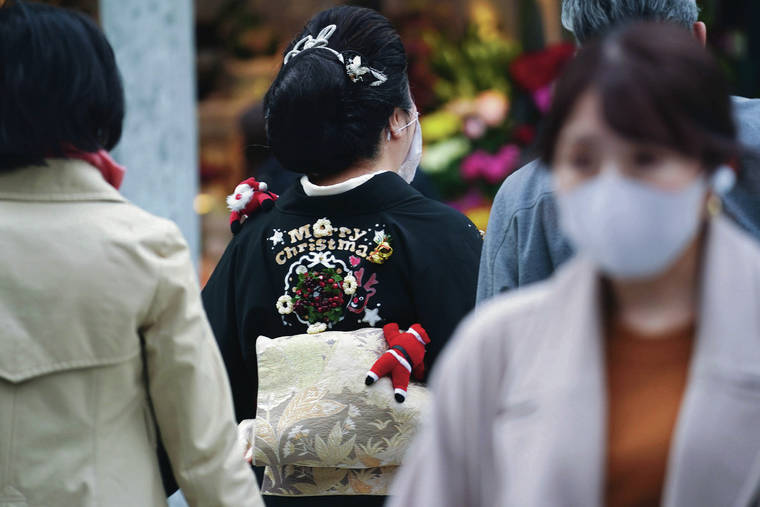Why Japan is largely a spectator in the coronavirus vaccine race

ASSOCIATED PRESS
A bit of cheer: A woman with festive touches on her traditional kimono walks among masked shoppers in the Ginza district in Tokyo. The whimsical sight is stark contrast to a steady rise of COVID-19 cases in Japan.
TOKYO >> Japan’s development of COVID-19 vaccines is far behind that of other countries, and the Japanese public is unlikely to have access to domestic vaccines until 2022.
Industry sources blame the situation on a failure to promote consolidation within the pharmaceutical industry and the sheltering of small Japanese companies from international competition.
The day the U.K. became the first western country to begin inoculating its citizens, biotech startup AnGes Inc. — Japan’s front-runner — announced it had started a mid- to late-stage clinical trial of its vaccine.
A total of 52 vaccine candidates were in clinical evaluation worldwide as of mid-November, according to the World Health Organization. The one under development by AnGes was the only Japanese contender. Other candidates from Japan are still in pre-clinical evaluation.
In the past, Japan took the lead in developing vaccines, such as the MMR vaccine for measles, mumps and rubella, said Tetsuo Nakayama, director of the Japanese Society of Clinical Virology. But after the government lost a series of lawsuits in the 1990s seeking damages for the vaccine’s side effects, the situation changed dramatically. In 1993, Japan’s MMR vaccination program was discontinued amid intense public concern.
“It’s not that Japan lacks the development capability,” he said. “But after the government losses, it did not actively promote development of new vaccines. That created a vaccine gap that lasted for more than 10 years, during which Japan fell far behind other countries.
Don't miss out on what's happening!
Stay in touch with breaking news, as it happens, conveniently in your email inbox. It's FREE!
“The lack of initiative from the government led to few financial and human resources for vaccine development, which inevitably slowed the pace of development.”
Japan has faced other hurdles as well. While four large pharmaceutical companies have dominated 70% of global vaccine markets, Japanese companies have remained much smaller. This has resulted in research and development capabilities and international competitiveness that pales in comparison, according to a government advisory task force.
A 2016 report by the task force said the country needs to move away from a system that protects the industry from international competition while remaining slow to adopt vaccines made overseas.
In 2008, for example, Japan was among the last countries in Asia to begin vaccinations for the lethal Haemophilus influenzae type B. Other developed nations had started vaccinations more than 10 years earlier.
AnGes plans to conduct a large-scale late-stage clinical trial next year and is reportedly aiming to introduce its vaccine by the end of 2021.
Other companies, such as KM Biologics and Daiichi Sankyo Co., are planning to launch clinical trials next March. Isao Teshirogi, president of Shionogi & Co., said his company is aiming to enter a clinical trial by the end of the month, and a large-scale trial in Japan and overseas next year.



